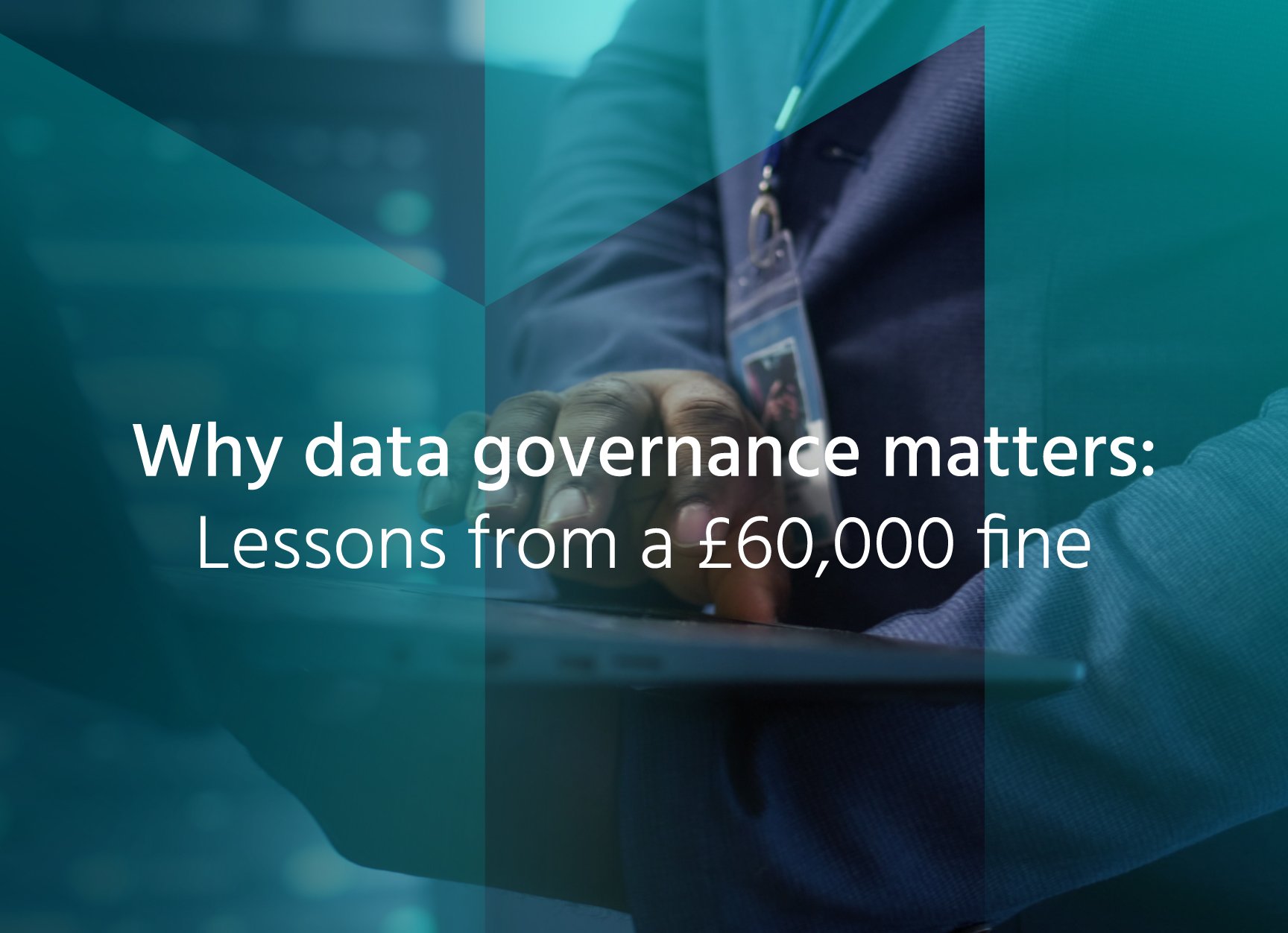Why data governance matters: Lessons from a £60,000 fine
Why data governance matters: Lessons from a £60,000 fine

In May 2025, a mid-sized UK law firm was fined £60,000 by the Information Commissioner’s Office (ICO) after suffering a data breach that exposed sensitive client information on the dark web. The ICO’s decision sends a clear message that regulators are starting to take a much tougher approach with organisations that fail to protect data — one that carries “serious monetary and reputational consequences.”
For business owners, this ruling is a wake-up call. Robust data governance and cybersecurity are no longer optional. It’s essential.
This blog explores why data governance is so critical, the risks of falling foul of the rules, and practical steps your organisation can take to become more secure and compliant.
What is data governance?
Data governance is a framework of practices that ensures you use data properly, in line with business objectives, legal requirements and best practices. When you implement it correctly, it’s like having always-on data protection practices in place.
When your company implements a strong data governance framework, you:
- Protect your organisation and the people whose data you process
- Reduce your risk profile
- Educate your staff on data issues and appropriate data use
- Build customer trust and improve your brand reputation
- Make your data work for you, reducing cost and improving operational efficiency
- Prepare for the successful implementation of AI tools like Microsoft Copilot
Good data governance is proactive, not reactive. You need to take action today to protect yourself against reputational, financial, and operational damage in the future.
The cost of getting data governance wrong
The ICO’s recent £60,000 fine for DDP Law is the most stark and visceral example of what happens when you neglect data governance or get it wrong. But it’s far from the only consequence of poor data governance. Other repercussions include:
- Legal liability – Beyond penalties and fines, companies can also incur significant legal costs brought about by regulatory bodies or clients who are victims of a breach
- Reputational damage – Clients and partners may lose trust in your organisation if you mishandle data
- Operational disruption – Responding to breaches and fulfilling regulatory requirements can drain resources, hampering your ability to serve clients.
Good data governance goes beyond regulatory compliance
While strong data governance practices ensure regulatory compliance, they also deliver wider business benefits like the following:
- Reduce risks from cyber attacks – Good governance includes incident response planning and recovery strategies, which will help you detect, contain and recover from cyber incidents efficiently.
- Lower data storage costs – by only keeping the data you need, you can significantly reduce storage costs.
- Fulfil data access requests – Well-governed data makes it easier to locate and provide information when individuals exercise their data rights.
- Faster incident response times – If a breach does occur, less data and better practices will make it easier to identify what’s affected and take action.
- Greater business potential – When you have control over your data, you can start to use it to improve your operations, deliver better customer experiences and uncover potential new revenue streams.
- Safer AI implementation – Data governance rules ensure AI tools like Copilot can’t access sensitive or personally identifiable information that can to internal disputes and data breaches.
Data isn’t just a byproduct of business. Data governance isn’t just a regulatory exercise. When you start to see data as oil that can propel your business forward, it becomes a lot easier to implement a data governance framework that will keep you secure and increase profitability.
How to build a data governance framework
Building a strong data governance framework requires expert help from a reputable IT support company or cybersecurity adviser. They will help you implement a strategy using the kind of step-by-step approach illustrated below.
1. Get leadership buy-in
Data governance initiatives require visible support and commitment from executive leadership in order to succeed. Articulate the specific problems that poor data quality causes, such as operational delays or compliance risks, quantifying these issues where possible.
Align your data governance objectives with broader business goals, demonstrating how improved data management can drive innovation and efficiency, not just compliance.
2. Define roles and responsibilities
Avoid ambiguity and create accountability by establishing clear roles like data owners and stewards - people who are responsible for managing data, improving data quality and approving access requests.
3. Map your data
Gain a comprehensive understanding of what data you hold and where it’s stored with a data mapping exercise. Catalogue all datasets and storage locations, then classify the sensitivity of each piece of data. Tag assets as public, confidential and restricted. Adopt a structured risk assessment process to identify, evaluate and mitigate data-related risks.
If you’re using an AI tool like Copilot, add Microsoft sensitivity labels to your data. You can configure Copilot to respect these labels, ensuring it can only process data it’s authorised to access.
4. Develop data ownership and access policies
Create policies that cover data collection, storage, sharing, retention and deletion and communicate them clearly. Implement role-based access controls to help staff abide by these policies and align AI tools like Copilot with them, too.
5. Implement data quality measures
Improve data accuracy and quality by standardising data formats and identifying missing or incomplete data. Regularly review data quality, too.
6. Prepare for data subject access requests and breach responses
Create clear procedures for handling data subject rights and responding to breaches. You can automate the response process using dedicated tools that locate and redact personal data within regulatory deadlines.
7. Review contracts and data-sharing agreements
When sharing data with third parties, ensure that all contracts include robust data protection clauses. Require vendors to sign Data Processing Agreements (DPAs) that mandate encryption, breach notifications and annual security audits.
Support good data governance with cybersecurity awareness training
Even the best-laid plans are ineffective if staff aren’t aware of them or don’t understand the dangers that cybercriminals present. Human error is one of the biggest causes of data breaches, making cybersecurity awareness training a vital part of any data governance framework.
With regular training, you can:
- Educate employees on the latest threats. Criminal tactics are constantly evolving. Regular training ensures staff know how to spot and avoid the most common methods, whether it’s a phishing email or a man-in-the-middle attack.
- Build a shared security culture. When everyone understands their role in protecting company and client data, cybersecurity becomes a shared responsibility. Employees are more likely to take ownership and react correctly when they identify a potential threat.
- Meet regulatory requirements. Regular cybersecurity training is becoming a common requirement in some industries.
- Significantly reduce your attack vector. Ultimately, regular cybersecurity awareness training will make your employees more aware of the threats your company faces and less likely to click on a suspicious link.
At Method, we run simulated phishing attacks and provide ongoing, automated security awareness training to keep threats at the front of your employees’ minds.
Build a better approach to data governance with Method
The ICO’s £60,000 fine is a reminder that regulators expect organisations — especially those handling sensitive data — to have robust data governance and security measures in place. But compliance isn’t just about avoiding fines. With the right approach, data governance can reduce costs, simplify operations, and build trust with clients.
By embedding strong governance and investing in cybersecurity awareness, your organisation can minimise risk, respond effectively to incidents and unlock the full value of your biggest asset, data. Speak to one of our experts to learn how Method can help you protect and maximise your data today.
Share this
You May Also Like
These Related Stories

What the M&S IT issue teaches us about cybersecurity and disaster recovery
.png?width=750&height=542&name=Blog%20Image%20feature%20(20).png)
The Benefits of IT Support for Law Firms
.png?width=750&height=542&name=Blog%20Image%20feature%20(10).png)
No Comments Yet
Let us know what you think